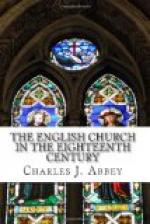[Footnote 611: H.H. Milman. Early History of Christianity, 1840, ii. 237.]
[Footnote 612: H.H. Milman, Lat. Christianity, 1857, iii. 270, vi. 263, 287; R.A. Vaughan, Hours with the Mystics, i. 49, 152.]
[Footnote 613: Milman’s Lat. Christianity, vi. 371-80; Winkworth’s Life and Times of Tauler, 186.]
[Footnote 614: M.J. Matter’s Histoire du Christianisme, 4, 347; H.T. Rose, Protestantism in Germany, 50.]
[Footnote 615: C. Leslie’s Works, ‘The Snake in the Grass,’ and ‘Defence, &c.’ Id. vols. iv. and v. passim; R.A. Vaughan’s Hours with the Mystics, ii. 255-60. Barclay’s Apology, 339.]
[Footnote 616: N. Spinckes, New Pretenders to Prophecy, 1709, 402, &c.]
[Footnote 617: Vaughan, ii. 165-208.]
[Footnote 618: Winkworth’s Life of Tauler, 172.]
[Footnote 619: J. Wesley, ’Letter to the Bishop of Gloucester.’—Works, ix. 137, 142.]
[Footnote 620: Wesley’s Journal, quoted by Lavington, Enthusiasm, &c., 271.]
[Footnote 621: Works, ix. 121; and Journal, 1738-43, quoted by Warburton, ’Doctrine of Grace.’—Works, iv. 605-75.]
[Footnote 622: Works, ix. 143.]
[Footnote 623: Barclay’s Apology, 339. Cf. Wesley’s ’Letter to W. Downes,’ 1759. Works, ix. 104-5.]
[Footnote 624: Wesley’s Plain Account of the People called the Methodists, 6th ed. 1764, 4.]
[Footnote 625: ‘Predestination calmly considered,’ 1745.—Works, x. 267.]
[Footnote 626: Behmen, Three Principles, chap. xxvi.]
[Footnote 627: ’Answer to Lavington.’—Works, ix. 50; ’Letter to Mr. Law,’ id. 505.]
[Footnote 628: Winkworth’s Life, &c., of Tauler, 96]
[Footnote 629: Tauler, ‘Sermon for Third Sunday after Epiphany,’ id. 223.]
[Footnote 630: Id. 86, 137-8.]
[Footnote 631: H. More’s note to Sec. 44 of Enthus. Triumphatus.]
[Footnote 632: C. Leslie, Works, iv. 5-8; Lavington, 346.]
[Footnote 633: Mosheim’s Ecclesiastical History, 1758, v. 86 (note); Tyerman, Oxford Methodists, 194; Wesley, continually; &c.]
[Footnote 634: A. Gilchrist’s Life of W. Blake, 331.]
[Footnote 635: Warburton called him and his followers ’our new Cabalists.’—Letter to Doddridge, May 27, 1758.]
[Footnote 636: A full statement of Hutchinson’s views may be found in the Works of G. Horne, by W. Jones (of Nayland), Pref. xix-xxiii, 20-23, &c. His own views were visionary and extreme. Natural religion, for example, he called ‘the religion of Satan and of Antichrist’ (id. xix). But he had many admirers, including many young men of promise at Oxford (id. 81). They were attracted by the earnestness of his opposition to some theological tendencies of the age. It was to this reactionary feeling that his repute was chiefly owing. ’Of Mr. Hutchinson we hear but little; his name was the match that gave fire to the train’ (id. 92).]




